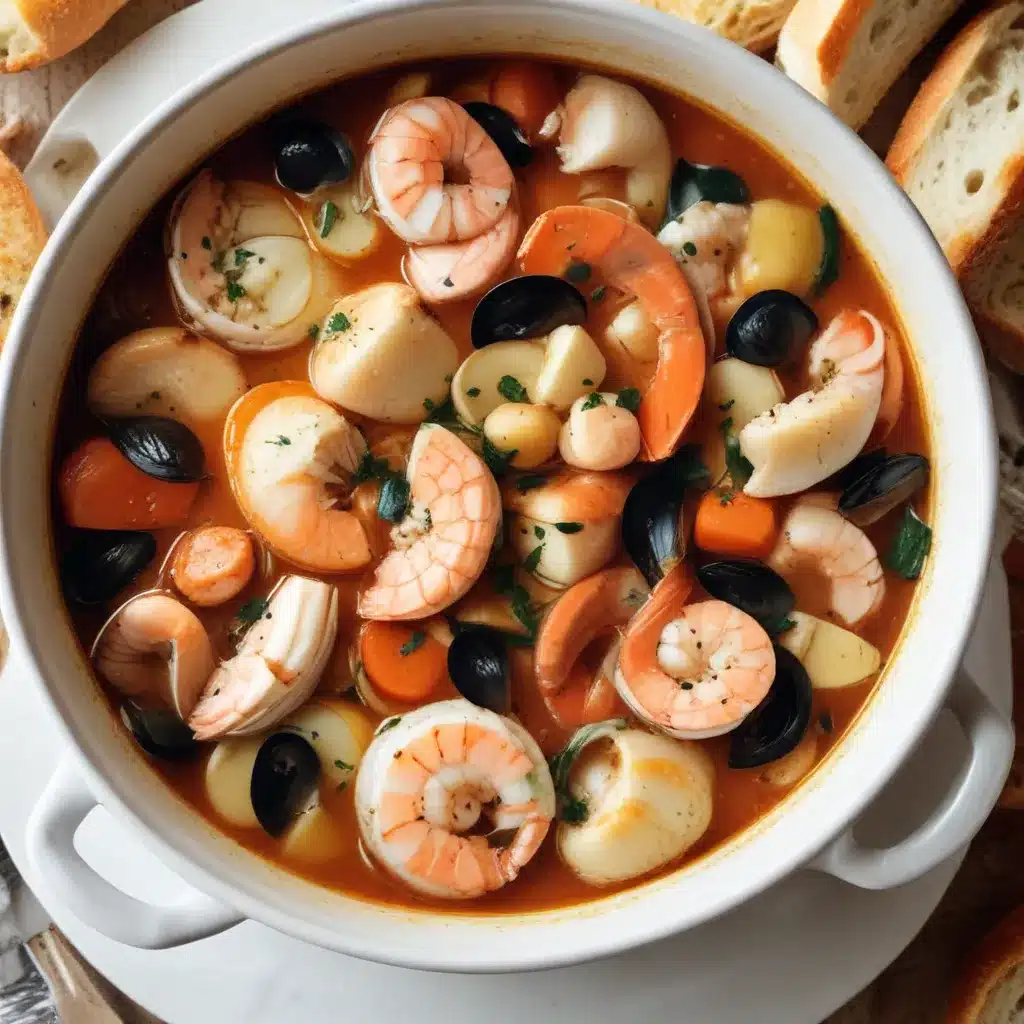
Seafood Bouillabaisse: Classic French Seafood Stew
Imagine a savory, aromatic seafood stew brimming with tender cod, plump mussels, succulent shrimp, and rich scallops – all simmered in a flavorful broth infused with saffron, fennel, and garlic. This is the essence of bouillabaisse, the quintessential seafood stew hailing from the coastal city of Marseille in the south of France.
Seafood Ingredients
At the heart of any memorable bouillabaisse lies a diverse array of fresh, high-quality seafood. While the exact combination can vary, a classic recipe often includes a mix of white fish like cod or halibut, along with mussels, clams, shrimp, scallops, and sometimes even lobster or crab. The key is to source the freshest, most sustainable seafood available, often from a trusted local fishmonger.
When preparing the seafood, ensure the fish fillets are cut into thick, even pieces, the shellfish are thoroughly cleaned and debearded, and the shrimp and scallops are left whole. This allows each ingredient to cook at the optimal rate, resulting in a harmonious blend of textures and flavors.
Broth Composition
At the foundation of bouillabaisse is a flavorful, tomato-based broth that serves as the canvas for the seafood to shine. This broth is typically made by simmering a combination of fish bones, shrimp shells, and aromatic vegetables like onions, fennel, and garlic. The addition of saffron lends a vibrant golden hue and a subtle, earthy sweetness to the broth, while a splash of white wine provides a touch of acidity to balance the richness.
The key to an exceptional bouillabaisse broth is to allow the flavors to meld and develop over time. After the initial sautéing of the vegetables, the broth should be allowed to simmer for at least 30 minutes, allowing the fish bones and shells to release their essence and create a deeply savory, umami-packed base.
Aromatic Vegetables
While the seafood is the undisputed star of bouillabaisse, the supporting cast of aromatic vegetables plays a crucial role in building the stew’s complex flavor profile. Onions, fennel, and garlic are typically sautéed in a mixture of olive oil and butter until softened and fragrant, providing a solid foundation for the other ingredients to build upon.
Diced tomatoes, either fresh or canned, are then added to the mix, along with a touch of tomato paste to further deepen the broth’s richness. The vegetables are allowed to simmer gently, allowing their flavors to meld and mellow, creating a harmonious base for the seafood to shine.
Herbs and Spices
In addition to the saffron, bouillabaisse often features a blend of aromatic herbs and spices that lend depth and complexity to the dish. Thyme, bay leaves, and orange peel are common additions, providing a subtle earthy and citrusy note that complements the seafood beautifully.
A pinch of cayenne pepper or piment d’Espelette (a mild, smoky chili pepper from the Basque region of France) can also be used to add a touch of heat and complexity, while fresh parsley or chives are often used as a final garnish to brighten the flavors.
Serving Suggestions
No bouillabaisse experience is complete without the classic accompaniment of crusty, toasted baguette slices and a dollop of rouille – a spicy, garlicky mayonnaise-based sauce. The bread is perfect for sopping up the flavorful broth, while the rouille adds a tangy, piquant contrast to the rich seafood.
When it comes to beverages, a chilled Provençal rosé or a crisp, fruity Côtes du Rhône white wine are both excellent pairings, their acidity and bright flavors cutting through the stew’s richness.
Cooking Techniques
The key to a successful bouillabaisse lies in the careful execution of the cooking techniques. The seafood is typically added in stages, with the heartier, longer-cooking fish like cod or halibut going in first, followed by the quicker-cooking shellfish like mussels, clams, and shrimp. This ensures that each ingredient is cooked to perfection, retaining its tender texture and fresh flavor.
The stew is then gently simmered, rather than boiled, to prevent the seafood from becoming tough or rubbery. Finally, the bouillabaisse is garnished with a sprinkle of fresh herbs, a drizzle of good-quality extra virgin olive oil, and a squeeze of lemon juice to brighten the flavors.
Regional Variations
While the Marseille-style bouillabaisse is the most well-known version, there are several regional variations of this iconic seafood stew. In the Catalan region of Spain, for example, the bouillabaisse is often made with a different blend of seafood, including
monkfish, rockfish, and langoustines, and features a broth with a more pronounced tomato flavor.
In the Mediterranean islands, the bouillabaisse may incorporate local ingredients like sea urchin or octopus, while some coastal regions of Italy and Spain have their own unique takes on the dish, such as the cioppino of San Francisco or the zarzuela of Catalonia.
Nutritional Benefits
Bouillabaisse is not only a culinary delight but also a nutritional powerhouse. The variety of seafood used in the stew provides a rich source of protein, as well as omega-3 fatty acids that are essential for heart and brain health. The tomato-based broth is also a good source of vitamins and antioxidants, making bouillabaisse a well-balanced and wholesome meal.
Whether you’re a seasoned seafood enthusiast or a newcomer to the world of bouillabaisse, this classic French dish is sure to impress with its complex flavors, sumptuous textures, and rich cultural heritage. So gather your ingredients, fire up the stove, and transport yourself to the sun-drenched shores of Marseille with every delectable spoonful of this magnificent seafood stew.

